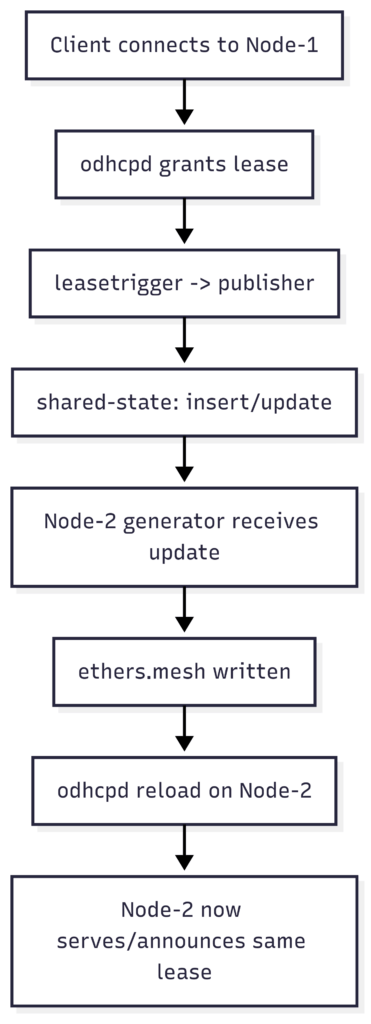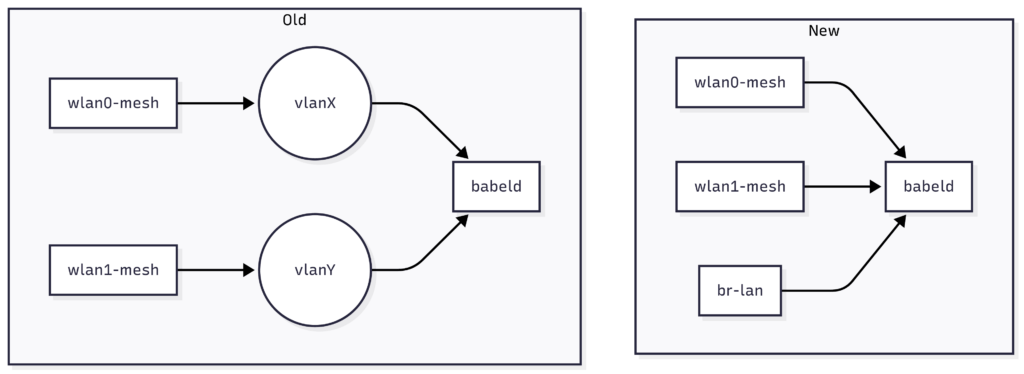This summer I focused on removing LibreMesh-specific glue where OpenWrt already has a solid upstream solution, and on tightening integration with OpenWrt services:
- Task 1 — Reboots via OpenWrt’s watchcat: new lime-hwd-watchcat module generates /etc/config/watchcat from LibreMesh UCI and reloads the service automatically. It replaces the custom deferrable-reboot.
- Task 2 — Move DHCP to odhcpd + cluster-wide lease sharing: prototype package that makes odhcpd the main DHCPv4 server (maindhcp=1) and shares leases across nodes via CRDTs, using ubus and leasetrigger.
- Task 3 — Remove VLAN wrappers from Babel: PR switches lime-proto-babeld to run on base ifaces and br-lan (DSA), adds a small nftables guard to avoid L2 multicast leaking Babel traffic from bat0 into the bridge.
- Task 4 — Plan for an L3-only LibreMesh profile: opened an L3-only mesh issue (no batman-adv/anygw) to scope the work and collect feedback.
Project goals
- Simplify LibreMesh by adopting OpenWrt-native components when they are equivalent or better.
- Reduce maintenance burden in LibreMesh packages by deleting code where upstream covers it.
- Keep behavior observable & testable with CI/unit tests and simple field tests on real routers.
What was built
1) Integrate OpenWrt’s watchcat via LibreMesh HWD
Why: OpenWrt ships watchcat for scheduled reboots/network checks. Using it upstream avoids reboot logic and gains a familiar UI.
What: lime-hwd-watchcat (Lua) reads LibreMesh UCI (config hwd_watchcat), generates the corresponding /etc/config/watchcat sections, cleans stale ones, and reloads the service. The package lives in lime-packages and targets stock OpenWrt watchcat.
Result: Reboots and connectivity checks are handled by upstream watchcat, visible in LuCI, with configuration owned by LibreMesh.
2) Replace dnsmasq DHCP with odhcpd
Why: odhcpd is OpenWrt’s native DHCP/RA daemon, well-integrated with ubus, and already authoritative for IPv6; enabling it for IPv4 simplifies the stack.
What: prototype package shared-state-odhcpd_leases:
- UCI defaults set dhcp.odhcpd.maindhcp=1, point leasetrigger to our publisher, and register a community scoped CRDT.
- Publisher: on lease change, call ubus dhcp ipv4leases, distill to IP → {mac, hostname}, publish to CRDT.
- Generator: on CRDT updates, atomically write /tmp/ethers.mesh and reload odhcpd so foreign leases are served locally too.
(“Leasetrigger” behavior is an odhcpd feature used here to emit on lease changes.)
In the field: two LibreMesh nodes converge on the same lease table within seconds; uci show dhcp reflects maindhcp=1. Tech references for odhcpd and UCI options: docs & source.

3) Remove VLAN interfaces from Babel (run on base ifaces / br-lan)
Why: Historically LibreMesh created per-radio VLANs for Babel. On modern DSA targets this adds complexity and hides interface intent. Running babeld on br-lan (wired) and radios directly is simpler and yields the right link metrics by default.
What: rewrites lime-proto-babeld to:
- Configure Babel on base ifaces and add a br-lan interface (type=wired).
- Drop the legacy “VLAN-on-wlan” indirection.
- Add a small nftables ingress guard on bat0 to prevent Babel L2 multicast flooding into br-lan, which could otherwise create “ghost wired neighbors”.
(Babel uses UDP 6696 and link-local multicast ff02::1:6 / 224.0.0.111; the guard drops those on bat0.)

Notes: The PR targets DSA (not swconfig). It also documents what to add in lime-node to enable babeld proto explicitly. See PR conversation, examples and nftables snippet.
4) Toward an L3-only LibreMesh profile
What: Today LibreMesh typically mixes BATMAN-adv (L2) and Babel (L3): BATMAN-adv makes the whole mesh look like one big Ethernet (single broadcast domain), while Babel does hop-by-hop IP routing. An L3-only profile would switch fully to Babel for mesh connectivity, drop BATMAN-adv and anygw, and give each node its own LAN prefix.
I opened an issue to scope the work: goals, migration path, and checks the community can run while we iterate.
- Before (BATMAN-adv + anygw): clients across the mesh often see the same IPv4 gateway address; the mesh feels like one flat LAN.
- After (L3-only): each node runs a DHCP server for its /24 (or /64 in IPv6). Clients connected to node A live in A’s subnet; traffic to node B’s subnet routes via Babel.
Minimum plan
- Drop L2 mesh: exclude BATMAN-adv bits (lime-proto-batadv, ubus-lime-batman-adv) and remove anygw.
- Keep it pure L3: enable Babel (lime-proto-babeld) on mesh radios and on br-lan. (Related: my PR removes the legacy VLAN-on-wlan layer so Babel runs directly on the base ifaces.)
- Per-node addressing: use LibreMesh’s main_ipv4_address/main_ipv6_address patterns to give every router its own LAN prefix.
- DHCP/RA: ensure a DHCP/RA server per node.
- Gateways: if you want “plug Internet anywhere,” pair L3-only with babeld-auto-gw-mode so default routes are advertised only when WAN is healthy.
Current state (as of Aug 25, 2025)
- watchcat integration: packaged in lime-packages (app + docs page) and usable today; config lives in LibreMesh UCI, rendering to standard OpenWrt watchcat.
- odhcpd migration: working prototype with CRDT lease sharing; evaluation and broader testing tracked in Issue #1199.
- Babel changes: PR #1210 open with review/approvals from maintainers.
- L3-only profile: Issue #1211 open for community discussion and follow-ups.
What’s left / next steps
- watchcat: collect feedback from communities and tune sane defaults per device profiles.
- odhcpd: expand tests (IPv6 RA/DHCPv6 + v4 coexistence), harden failure modes, and benchmark lease propagation on dense meshes. Track in #1199.
- Babel PR #1210: finalize DSA docs, test swconfig fallback or explicitly gate to DSA-only in code, and validate the
bat0ingress guard on more topologies. - L3-only: produce a minimal profile, migration guide (no
batman-adv, noanygw).
Lessons learned
- Upstream keeps projects healthy. Using existing, maintained components cuts long-term maintenance and aligns you with a larger ecosystem.
- Small, reviewable changes earn fast feedback. I saw how clear PR descriptions, minimal diffs, and reproducible test notes make reviews smoother, because maintainers can reason about the change quickly.
- Communication is part of the code. Good issues/PRs explain why, not just what; they show logs, decisions, and trade offs.
- Deleting code is a feature. Replacing custom code with upstream tools (watchcat instead of deferrable-reboot or odhcpd instead of dnsmasq-DHCP) taught me that reducing surface area often improves reliability.
- Open Source Community. I’ve learned a lot of how open source community works, everyone prioritizes that the other person can understand and use the code in a simple way.
Other links references
Do we need VLAN for Babeld interfaces? (Mailing list discussion)
Conclussion
This summer I worked and learned a lot. I’m proud to have met my tutors’ expectations and contributed to a project like LibreMesh.
I want to thank my mentors Ilario and Javier for trusting and giving me this opportunity, especially their patience and compromise, they were amazing!